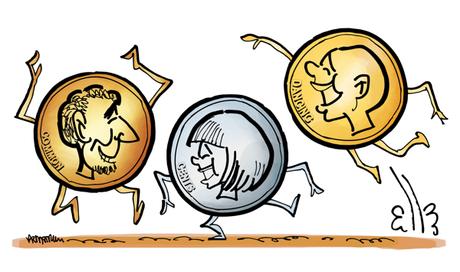

 A lot of brands and marketers steer clear of humor. They think it makes them look unprofessional. They think “humor” means telling jokes.
A lot of brands and marketers steer clear of humor. They think it makes them look unprofessional. They think “humor” means telling jokes.
It’s NOT telling jokes.
It’s NOT standup comedy.
It’s NOT trying to make people LOL.
Those definitions are much too narrow.
So what is it, then?
Core Meaning





Here’s the best definition I know, courtesy of writer and critic Clive James:
“Common sense and a sense of humor are the same thing, moving at different speeds. A sense of humor is just common sense, dancing.”
Life is a dance, a relationship is a dance, marketing is a dance.
Dancing is about communication, and humor makes it possible: it’s being genial, positive, upbeat, talking with a smile, and being ready to laugh and poke fun at yourself. It’s about putting others at ease.
Comedy & Drama Are A Team



And consider: comedy and drama complement each other. The best playwrights know this. Jerome Lawrence, best known for Inherit The Wind, put it this way:
“The best playwrights– Tennessee Williams, for instance– will puncture the most serious moment with an outrageous laugh. The audience delights in it.
“They need the relief. They need laughter– or what Norman Cousins calls ‘inner jogging’– for the joy of life.
“The more an audience laughs, the more it feels.
“Shakespeare knew this– there’s comedy in his most serious plays.”

 Infotainment
Infotainment



Lee Odden of TopRank Marketing echoes this idea when he says you have to connect with buyers “on both an intellectual and an emotional level.” That doing so will help you stand out from competitors who take a strictly intellectual (= informational) approach.
He sees “infotainment”– content that both informs and entertains– as the key to attracting and engaging prospects.
Intellect and emotion. Information and entertainment. Drama and comedy.
For best results, you need to leaven the one with the other.
Grabs Attention, Lowers Shields



Storyteller and creative strategist Kathy Klotz-Guest writes that “as content marketing explodes, so too, does the volume of noise. You have about 7 seconds to grab attention.”
Humor does that. Kathy says it does something else, too:
“Laughter lowers the intellectual shield your busy prospects have up all day just to survive the messaging onslaught.
“Humor opens up a space for connecting because it disrupts the expected pattern.”

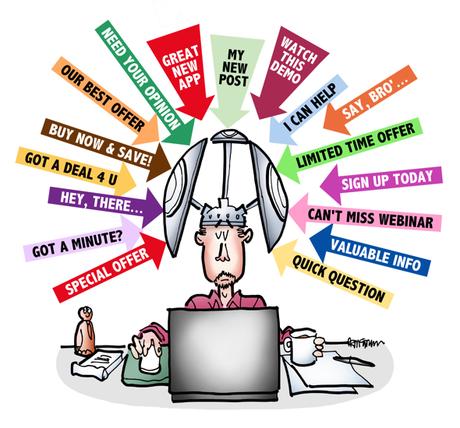
Shared Humanity & Trust

Tim Washer points out that a lot of comedy comes from pain. When we use humor to address a prospect’s problem, we’re showing that we understand his point of view.
Tim also maintains that if you can make someone laugh, then you’ve made the most intimate connection you can make.
Humor opens up a channel. A channel called “shared humanity.”
It’s hard to relate to a salesman who speaks jargon, but it’s easy to relate to someone you’ve shared a laugh with— and that builds trust. 
Personality

Consider, too, that humor is a dimension of personality. When we say someone has a great personality, we usually mean someone who’s genial, warm, upbeat, funny— someone who draws you in.
In her article about “boring” big brands that use humor, Kim Speier notes that humor can be especially helpful to companies in highly-competitive or saturated industries. She asks:
“What better way to stand out from those that sell a product
or service of similar quality and price than by letting your company’s personality shine?”
Humor gives you a way to do something absolutely essential: set yourself apart from your competitors.
And we like people with warm upbeat personalities— which is why your brand needs to be likable.
Michael Brenner, CEO of Marketing Insider Group, says being likable helps your audience relate to you, and makes them more likely to engage.
Retains Attention

A lot of public speakers open with a joke. They know it grabs attention and puts the audience in a relaxed receptive mood.
But it’s not enough to grab attention— you have to retain it. True for presentations, true for blog posts or any other kind of content.
Andrew Davis is one of my favorite speakers who presents on marketing topics. He sprinkles humor throughout his talks to hold the audience’s attention.
You might be thinking: I can’t be funny all the time!! 
There’s that key point again: humor isn’t about telling jokes, it’s about keeping things light. It’s that light touch that makes communication possible.
Humor As A Teaching Tool

Sofia Fenichell is a mom whose startup, Mrs. Wordsmith, produces The Storyteller’s Illustrated Dictionary. It uses wacky illustrations to help kids learn new words. The humor keeps them engaged and makes learning fun.
It’s important to note that the goal here is learning, not being funny or getting laughs. The humor has to facilitate learning, which means it can’t be a distracting influence.
Same with marketing.
Humor succeeds when it’s relevant to your target audience; then it can hold their attention and improve retention.
College professor Ron Berk, who uses all kinds of zany humor to teach biostatistics to college students, puts it this way:
“What I do and how I teach is all about the students. It has nothing to do with me.
“I’m tapping into their multiple intelligence needs and their culture so that they can understand the material in their terms.”
Carol Schlef, RNC, MSW, a women’s health educator, takes the same approach.
While teaching pregnant teenagers about proper nutrition, she noticed they seemed bored and disinterested. So she created a special “food pyramid for teens” that identified the 4 major food groups as “refined sugar, fat, caffeine, and salt.”
The teens laughed at the absurdity, and were more receptive when she introduced them to healthier ways of eating.
There’s a lesson there: comedy is subjective. You need to understand your target audience and how they’re likely to respond. 
Here’s a good rule of thumb. It’s from a book called The Humor Code by Peter McGraw & Joel Warner.
“It’s not whether or not you’re funny, it’s what kind of funny you are.” 
I hear that as “what kind of fun you are.” Because humor in marketing is not about getting laughs, it’s about keeping things light and engaging your audience on their terms.
It’s Not Just Short Attention Spans

Earlier, we spoke about short attention spans (“You have about 7 seconds to grab attention.”)
But marketers are also up against what psychologist and Nobel Prize winner Daniel Kahneman calls “fast thinking.”
In his best-selling book, Thinking, Fast and Slow, Kahneman says our minds have two systems of thought: the first is fast, automatic, instinctive– we can’t really control it.
The second requires logic and analysis: it’s slow, deliberate, and takes sustained effort. In other words, it’s painful.
Kahneman sums it all up with this great line:
“Thinking is to humans as swimming is to cats; they can do it but they’d prefer not to.”
We don’t like to think too hard. We make emotional choices, not rational ones.

Behavioral scientist Richard Shotton puts it this way:
“Even when we think we’re making reasoned conscious decisions often the conscious mind is merely post-rationalizing decisions that have already been made.”
Paul Cash, who runs a B2B storytelling agency, has this advice:
“Make sure the content you create is simple, truthful and engaging. Make social, social. Too many facts and figures will turn buyers away.”
I hear him saying: use humor. Not to get laughs, but to create what Lee Odden calls info-tainment: content that’s entertaining, upbeat, and fun.
Perfect example: advertising jingles. You don’t have to think too hard to “get” them, and you remember them because they’re fun. Wrigley’s sold a lot of chewing gum with this one:
Double your pleasure, double your fun, with double good, double good, Doublemint Gum!

Shares
We all want people to share our content, and what gets shared the most? The funny stuff.
Al Lautenslager, author of Market Like You Mean It, puts it this way: 
“Humor is social by nature; people share funny stories all the time. It’s no secret or surprise that the most viral online videos are those that do the best job of making you laugh.
“A humorous brand is a confident brand, and a confident brand is in demand– and gets noticed.”
Moonpie



Moonpie has been in business for over 100 years. They make graham cracker and marshmallow snack cakes. They’d fallen off the radar of most young people, and needed a way to reconnect. 
Their marketing agency revamped their Twitter account, giving it a quirky, absurdist feel. In December 2017, Moonpie had 42K Twitter followers; today it has almost 300K. Some examples of their tweets:

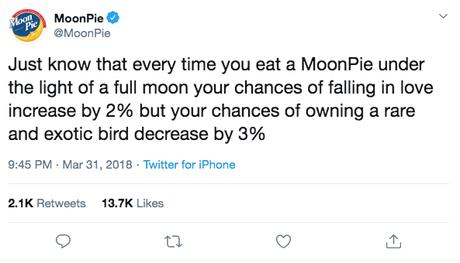

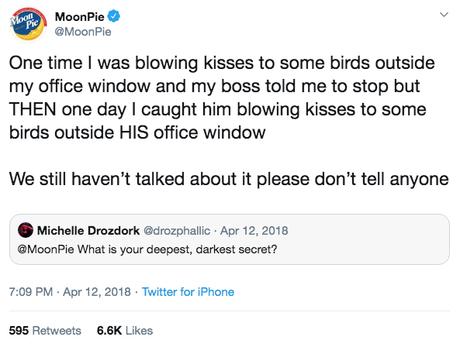


Here’s a much simpler, small biz example: 
Main Crust Pizza



They post dumb jokes and puns on it, and change them regularly. I take a look every time I drive by. A couple of examples:
“I fell into a furniture upholstery machine. But I’ve recovered.”
“Time to start exercising and eating healthy. Just kidding— order a pizza.”
Sometimes it’s fun to groan. They’re the “pizza place with the joke sign.” People remember them, and their sign says they’re a fun place to go.
The idea of using humor in marketing goes way back— here’s a great retro example:
Yule’s Barber Shop



Simple: he had a million comic books you could read while you were waiting. It was tough putting them down in the middle of a story when it was your turn.
Mr. Yule used humor in a prepackaged form that was perfect for his audience.
Confidence

Humor projects confidence, as Mr. Lautenslager stated above: 
“A humorous brand is a confident brand, and a confident brand is in demand–and gets noticed.”
Kevin Daum, author of Roar! Get Heard in the Sales and Marketing Jungle, echoes that view: 
“Combined with knowledge, humor enhances expertise, demonstrating confidence and strength.”
One last rather cosmic thought courtesy of editor Alison Beard at Harvard Business Review: in The Humor Code, McGraw & Warner cite a line from the anthropologist Edward Hall:
“If you can learn the humor of a people and really control it, you know that you are also in control of nearly everything else.”
Now that’s confidence.
Small Biz Advantage

Jason Miller, Marketing Leader at Microsoft, says humor helps level the playing field between big-budget ad agencies and small brands.
Digital marketer Ann Handley concurs: 
“Small businesses might be challenged with limited budgets and resources, but they nonetheless have an advantage when it comes to creating humorous marketing.
“Big companies generally have more bureaucracy and longer approval processes, making it difficult for them to be nimble or edgy in their marketing.”
Miller says brands should take a tip from comedian Jerry Seinfeld and take a look at their everyday situations and ask: “What’s funny about this?”
Perhaps a better question: what’s fun, amusing, positive, upbeat?
Why do we like working here? What fun and interesting aspects of our business are we not seeing, simply because we see them every day and take them for granted?
A lot of times that equates to the people, the employees, and what goes on behind the scenes.

Jordan Winery




My favorite was their blooper reel, showing all the flubs and outtakes: very funny, but the best kind of funny— very human. I was ready to shell out for a bottle on the spot. Take a look.





I’ve seen some great non-digital examples as well.
Good Fortune Jewelry & Pawn

A jewelry store in Keene, NH, turned a back room into a performance space.
They called it The Neon Coconut because they had an electric sign with that name which had been used in a local theater production.
Local musicians performed, and you had to walk through the entire store to get to the back room.
Great way to support the arts and bring in potential customers at the same time.
Souvenir Shop

I was on a bicycle tour out west a few years ago, and we came upon a souvenir shop out in the middle of nowhere. There was a huge dinosaur skeleton out front, and it had a very odd look.
We stopped, of course, and I asked the owner what it was. “That’s a Cowhorsasaurus,” he said.
A local artist had constructed it out of cow and horse bones.
A joke, and a very successful one, because it brought people in. 
Clark’s Bears



Clark’s Bears (formerly Clark’s Trading Post, estab. 1928) is a family-owned roadside attraction in Lincoln, NH. Lots of rides and family-friendly amusements, including a trained bears show.

They also have a 2.5-mile steam-powered train ride, and here’s where the humor comes in: the train gets chased by the Wolfman who drives a rusty old junkheap and looks like a cross between a caveman and a pirate. He tells everyone to get off his land.

But he’s not so bad— you can have your picture taken with him after the ride. Great example of quirky humor that also functions as a talk trigger.





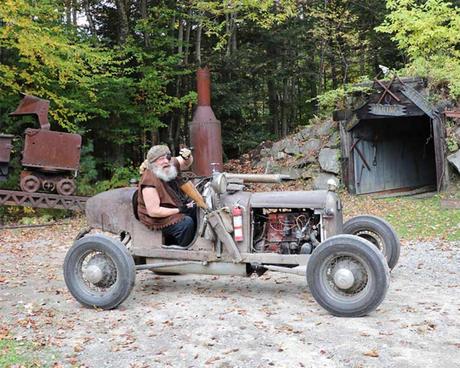

 Better Content
Better Content



Need another reason to put some humor in your marketing? Consider this line from advertising legend David Ogilvy:
“The best ideas come as jokes. Make your thinking as funny as possible.”
He’s right. Humor inspires creative leaps. Laughter makes it easier to think more broadly, and to free associate.
Ever had an idea that was a little “out there” but didn’t voice it because you were afraid of being judged? Or maybe you did some self-judging, and didn’t think the idea was good enough.
Humor frees us up, so we can take a break from self-monitoring.

A really good joke creates an a-ha! moment. It clicks. We get it. Humor puts us in a freer state of mind, making it more likely that we can “connect the dots” and solve a problem.
In the words of comedian John Cleese: “Creativity is all about play.”
Writing in Psychology Today, David Evans puts it this way:
“Surprise is at the heart of comedy. Surprise is also at the heart of creativity.

